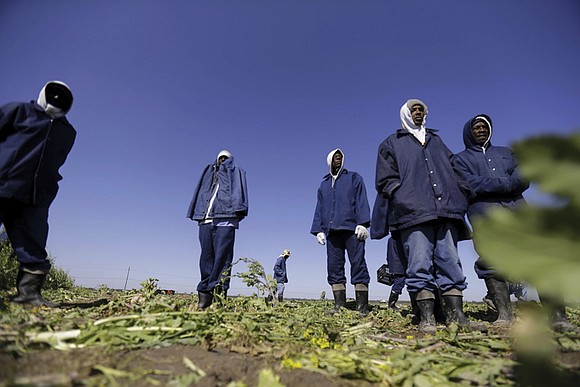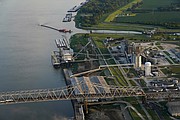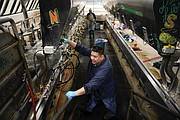Prisoners in the U.S. are part of a hidden workforce linked to hundreds of popular food brands
Robin McDowell and Marggie Mason/The Associated Press | 2/8/2024, 6 p.m.

ANGOLA, La. - A hidden path to America’s dinner tables begins here, at an unlikely source — a former Southern slave plantation that is now the country’s largest maximum-security prison.
Unmarked trucks packed with prison-raised cattle roll out of the Louisiana State Penitentiary, where men are sentenced to hard labor and forced to work, for pennies an hour or sometimes nothing at all. After rumbling down a country road to an auction house, the cows are bought by a local rancher and then followed by The Associated Press another 600 miles to a Texas slaughterhouse that feeds into the supply chains of giants like McDonald’s, Walmart and Cargill.
Intricate, invisible webs, just like this one, link some of the world’s largest food companies and most popular brands to jobs performed by U.S. prisoners nationwide, according to a sweeping two-year AP investigation into prison labor that tied hundreds of millions of dollars’ worth of agricultural products to goods sold on the open market.
They are among America’s most vulnerable laborers. If they refuse to work, some can jeopardize their chances of parole or face punishment like being sent to solitary confinement. They also are often excluded from protections guaranteed to almost all other full-time workers, even when they are seriously injured or killed on the job.
The goods these prisoners produce wind up in the supply chains of a dizzying array of products found in most American kitchens, from Frosted Flakes cereal and Ball Park hot dogs to Gold Medal flour, Coca-Cola and Riceland rice. They are on the shelves of virtually every supermarket in the country, including Kroger, Target, Aldi and Whole Foods.
And some goods are exported, including to countries that have had products blocked from entering the U.S. for using forced or prison labor.
Many of the companies buying directly from prisons are violating their own policies against the use of such labor. But it’s completely legal, dating back largely to the need for labor to help rebuild the South’s shattered economy after the Civil War. Enshrined in the Constitution by the 13th Amendment, slavery and involuntary servitude are banned – except as punishment for a crime.
That clause is currently being challenged on the federal level, and efforts to remove similar language from state constitutions are expected to reach the ballot in about a dozen states this year.
Some prisoners work on the same plantation soil where slaves harvested cotton, tobacco and sugarcane more than 150 years ago, with some present-day images looking eerily similar to the past. In Louisiana, which has one of the country’s highest incarceration rates, men working on the “farm line” still stoop over crops stretching far into the distance.
Toil and torture
Willie Ingram picked everything from cotton to okra during his 51 years in the state penitentiary, better known as Angola.
During his time in the fields, he was overseen by armed guards on horseback and recalled seeing men, working with little or no water, passing out in triple-digit heat. Some days, he said, workers would throw their tools in the air to protest, despite knowing the potential consequences.
“They’d come, maybe four in the truck, shields over their face, billy clubs, and they’d beat you right there in the field. They beat you, handcuff you and beat you again,” said Mr. Ingram, who received a life sentence after pleading guilty to a crime he said he didn’t commit. He was told he would serve 10½ years and avoid a possible death penalty, but it wasn’t until 2021 that a sympathetic judge finally released him. He was 73.
The number of people behind bars in the United States started to soar in the 1970s just as Mr. Ingram entered the system, disproportionately hitting people of color. Now, with about 2 million people locked up, U.S. prison labor from all sectors has morphed into a multibillion-dollar empire, extending far beyond the classic images of prisoners stamping license plates, working on road crews or battling wildfires.
Though almost every state has some kind of farming program, agriculture represents only a small fraction of the overall prison workforce. Still, an analysis of data amassed by the AP from correctional facilities nationwide traced nearly $200 million worth of sales of farmed goods and livestock to businesses over the past six years — a conservative figure that does not include tens of millions more in sales to state and government entities.
Much of the data provided was incomplete, though it was clear that the biggest revenues came from sprawling operations in the South and leasing out prisoners to companies.
Corrections officials and other proponents note that not all work is forced and that prison jobs save taxpayers money. For example, in some cases, the food produced is served in prison kitchens or donated to those in need outside. They also say workers are learning skills that can be used when they’re released and given a sense of purpose, which could help ward off repeat offenses. In some places, it allows prisoners to also shave time off their sentences. And the jobs provide a way to repay a debt to society, they say.
While most critics don’t believe all jobs should be eliminated, they say incarcerated people should be paid fairly, treated humanely and that all work should be voluntary. Some note that even when people get specialized training, like firefighting, their criminal records can make it almost impossible to get hired on the outside.
“They are largely uncompensated, they are being forced to work, and it’s unsafe. They also aren’t learning skills that will help them when they are released,” said law professor Andrea Armstrong, an expert on prison labor at Loyola University New Orleans. “It raises the question of why we are still forcing people to work in the fields.”
A shadow workforce with few protections
In addition to tapping a cheap, reliable workforce, companies sometimes get tax credits and other financial incentives. Incarcerated workers also typically aren’t covered by the most basic protections, including workers’ compensation and federal safety standards. In many cases, they cannot file official complaints about poor working conditions.
These prisoners often work in industries with severe labor shortages, doing some of the country’s dirtiest and most dangerous jobs.
The AP sifted through thousands of pages of documents and spoke to more than 80 current or formerly incarcerated people, including men and women convicted of crimes that ranged from murder to shoplifting, writing bad checks, theft or other illegal acts linked to drug use. Some were given long sentences for nonviolent offenses because they had previous convictions, while others were released after proving their innocence.
Reporters found people who were hurt or maimed on the job, and also interviewed women who were sexually harassed or abused, sometimes by their civilian supervisors or the correctional officers overseeing them. While it’s often nearly impossible for those involved in workplace accidents to sue, the AP examined dozens of cases that managed to make their way into the court system. Reporters also spoke to family members of prisoners who were killed.
One of those was Frank Dwayne Ellington, who was sentenced to life in prison with the possibility of parole after stealing a man’s wallet at gunpoint — a result of Alabama’s habitual offenders act. In 2017, Mr. Ellington, 33, was cleaning a machine near the chicken “kill line” in Ashland at Koch Foods — one of the country’s biggest poultry-processing companies — when its whirling teeth caught his arm and sucked him inside, crushing his skull. He died instantly.
During a years long legal battle, Koch Foods at first argued Mr. Ellington wasn’t technically an employee, and later said his family should be barred from filing for wrongful death because the company had paid his funeral expenses. The case eventually was settled under undisclosed terms. The Occupational Safety and Health Administration fined the company $19,500, saying workers had not been given proper training and that its machines had inadequate safety guards.
“It’s somebody’s child, it’s somebody’s dad, it’s somebody’s uncle, it’s somebody’s family,” said Mr. Ellington’s mother, Alishia Powell-Clark. “Yes, they did wrong, but they are paying for it.”
The AP found that U.S. prison labor is in the supply chains of goods being shipped all over the world via multinational companies, including to countries that have been slapped with import bans by Washington in recent years. For instance, the U.S. has blocked shipments of cotton coming from China, a top manufacturer of popular clothing brands, because it was produced by forced or prison labor. But crops harvested by U.S. prisoners have entered the supply chains of companies that export to China.
While prison labor seeps into the supply chains of some companies through third-party suppliers without them knowing, others buy direct. Mammoth commodity traders that are essential to feeding the globe like Cargill, Bunge, Louis Dreyfus, Archer Daniels Midland and Consolidated Grain and Barge — which together post annual revenues of more than $400 billion — have in recent years scooped up millions of dollars’ worth of soy, corn and wheat straight from prisons, which compete with local farmers.
The AP reached out for comment to the companies it identified as having connections to prison labor, but most did not respond.
Cargill acknowledged buying goods from prison farms in Tennessee, Arkansas and Ohio, saying they constituted only a small fraction of the company’s overall volume. It added that “we are now in the process of determining the appropriate remedial action.”
McDonald’s said it would investigate links to any such labor, while Archer Daniels Midland and General Mills, which produces Gold Medal flour, pointed to their policies in place restricting suppliers from using forced labor. Whole Foods responded flatly: “Whole Foods Market does not allow the use of prison labor in products sold at our stores.”
Bunge said it sold all facilities that were sourcing from correction departments in 2021, so they are “no longer part of Bunge’s footprint.”
Dairy Farmers of America, a cooperative that bills itself as the top supplier of raw milk worldwide, said that while it has been buying from correctional facilities, it now only has one “member dairy” at a prison, with most of that milk used inside.
To understand the business of prison labor and the complex movement of agricultural goods, the AP collected information from all 50 states, through public records requests and inquiries to corrections departments. Reporters also crisscrossed the country, following trucks transporting crops and livestock linked to prison work, and tailed transport vans from prisons and work-release sites heading to places such as poultry plants, egg farms and fast-food restaurants. A lack of transparency and, at times, baffling losses exposed in audits, added to the challenges of fully tracking the money.
Big-ticket items like row crops and livestock are sold on the open market, with profits fed back into agriculture programs. For instance, about a dozen state prison farms, including operations
in Texas, Virginia, Kentucky and Montana, have sold more than $60 million worth of cattle since 2018.
As with other sales, the custody of cows can take a serpentine route. Because they often are sold online at auction houses or to stockyards, it can be almost impossible to determine where the beef eventually ends up.
Sometimes there’s only one way to know for sure. In Louisiana, an AP reporter watched as three long trailers loaded with more than 80 cattle left the state penitentiary. The cows raised by prisoners traveled for about an hour before being unloaded for sale at Dominique’s Livestock Market in Baton Rouge.
As they were shoved through a gate into a viewing pen, the auctioneer jokingly warned buyers “Watch out!” The cows, he said, had just broken out of prison.
Within minutes, the Angola lot was snapped up by a local livestock dealer, who then sold the cattle to a Texas beef processor that also buys cows directly from prisons in that state.
Meat from the slaughterhouse winds up in the supply chains of some of the country’s biggest fast-food chains, supermarkets and meat exporters, including Burger King, Sam’s Club and Tyson Foods.
“It’s a real slap in the face, to hear where all those cattle are going,” said Jermaine Hudson, who served 22 years at Angola on a robbery conviction before he was exonerated.
He said it’s especially galling because the food served in prison tasted like slop.
“Those were some of the most disrespectful meals,” Mr. Hudson said, “that I ever, in my life, had to endure.”








